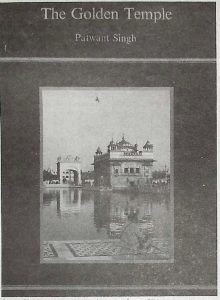
By Patwant Singh, 1988, 172 Pages
ET Publishing, Hong Kong
Available from
South Asia Books
P.O. Box 502
Columbia, Missouri 65205 Price $95.00 prepaid orders $88.00 including shipping
Patwant Singh, a Delhi based writer who had made his reputation in Indian architectural circles, has in recent years emerged as an increasingly active and effective voice on behalf of the Sikhs. Most Indians in India and abroad are aware of his many writings in the newspapers, particularly a book on Punjab that he coedited with Harji Malik, and by his numerous public appearances in India and. abroad where he has been most persuasive in his analysis of the quagmire in Punjab.
He has now compiled a brief history, illustrated with numerous photographs, of the Golden Temple. This work is indeed a labor of love and every Sikh should see it. To pursue it is to enjoy vicariously some of the majesty and the mystical aura of divinity that pervade this temple, the holiest of the Sikh shrines.
Patwant has been able to skillfully blend the historical narrative with the bricks and mortar and the physical structure of the temple. One can clearly visualize from Patwant’s presentation how the history of a people can infuse even buildings with a soul. The devotion that Sikhs everywhere feel for this place is unmistakably evident, for no other place has been so much a part of Sikh history and Sikh psyche. If only Indira Gandhi and her advisors had realized even an iota of that feeling of the Sikhs, perhaps she would have refrained from desecrating the temple with an army attack in 1984. Subsequently India might have followed a far more promising course than the current road to self-destruction.
For a loving breathing introduction to Sikhism, the book remains unmatched. Thus, despite its format, it is more than a coffee table book. Only 172 pages, the book is profusely illustrated with photographs, mostly in color. The photographs come from a variety of sources some are by contemporary photographers, many are from museum and private collections particularly from the United Kingdom others have appeared earlier in various magazines, all are first rate, The detail and complexity of the art in the Golden Temple service to Sikhs everywhere. The story is cleverly interwoven through the “cunning passages and contrived corridors” of history. I wish that Patwant had also included some photographs of the destruction wrought upon the Golden Temple and the Akal Takht by the Indian army in 1984 not so much to make a political statement as to bring the historical narrative up to date. Many photographs of those events in 1984 are available. To have left them out is indeed unfortunate, their inclusion would have
BOOK REVIEW
should interest and captivate the eye of a Sikh or a non-Sikh equally.
The Golden Temple remains to this day a moment to the ecumenical spirit to which it was dedicated by the Sikh Gurus; this book was published in 1988 to coincide with the 400th anniversary of the laying of the foundation stone of the temple. By collecting the material in one place and by examining it through the eyes of a devoted Sikhs, an amateur but respected historian and a consummate artist, Patwant has rendered a unique only enhanced the value of the book. Though understandable in a work of this sort, the price is hefty; at $88.00 the book is outside the pale of most Indians in India. Perhaps, it is only directed at the well to do expatriate Sihs and other connoisseurs of art. Certainly every Gurdwara (Sikh Temple) should have one as should most libraries, Any Sikh home that can afford it should not be without it,
I.J, Singh
(Dr. L.J. Singh is a Professor of Anatomy at New York University).
Article extracted from this publication >> July 28, 1989